The Mudhol Hound, also known as the Caravan Hound or Karwani, is one of India’s most iconic and ancient sighthound breeds. Originating from the Deccan Plateau region, this breed was traditionally used for hunting and guarding due to its unmatched speed, sharp eyesight, and loyalty. With a lean build, graceful gait, and fierce stamina, the Mudhol stands out for both elegance and endurance. Bred by local tribes and once favoured by royalty, this indigenous breed is now gaining recognition for its suitability as a family companion. Agile, alert, and low-maintenance, the Mudhol Hound is a true symbol of Indian heritage.
The Mudhol Hound or Caravan Hound has recently made its mark in India’s defense and law enforcement sectors. Known for their exceptional agility, sharp senses, and trainability, Mudhol Hounds have been inducted into trials by the Indian Army for roles such as surveillance, border patrolling, and detection. Their lean frame and high stamina make them ideal for long-range reconnaissance, especially in challenging terrains. Karnataka’s Canine Research and Information Centre (CRIC), in collaboration with the DRDO, has played a key role in preparing the breed for such duties. Their growing involvement highlights the Mudhol Hound’s potential as a valuable indigenous working dog.
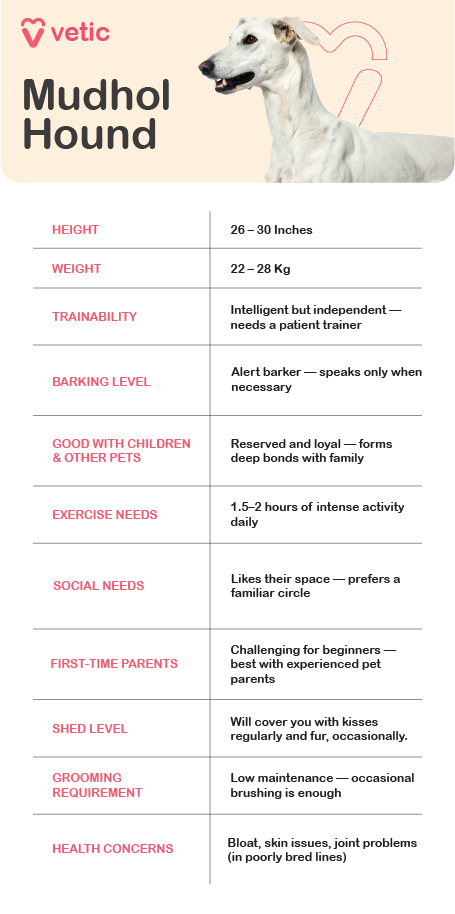
Complete Care Guide for the Mudhol Hound Puppy
Feeding & Nutrition Guide for Mudhol Hound or Caravan Hound Puppy
Let’s Talk Nutrition: What Food Does a Mudhol Hound Puppy Really Need?
Mudhol Hound puppies are lean, fast-growing, and packed with energy—and their diet needs to keep up. They need more than just calories; they need purposeful nutrition. We’re talking protein to build that athletic frame, healthy fats for development, and the right vitamins and minerals to support their overall growth.
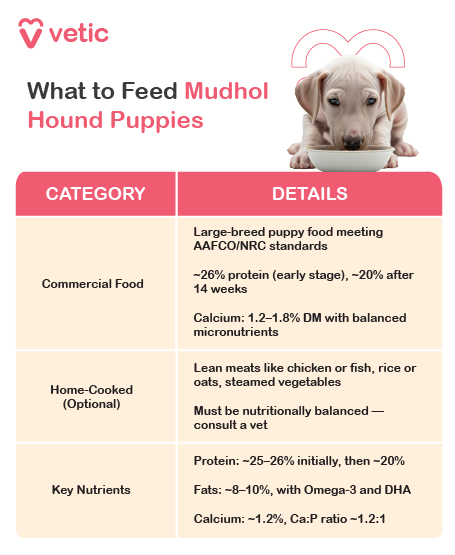
Here’s what the nutritional needs of a Mudhol Hound puppy look like:
- Protein Power: Lean meats like chicken, turkey, or fish are excellent sources of high-quality animal protein. These help develop strong muscles, which is vital for this athletic breed.
- Fats for Focus and Energy: Healthy fats like omega-3 and omega-6 fatty acids support brain development and provide sustained energy for their active lifestyle.
- Carbs That Don’t Weigh Them Down: Easily digestible complex carbs such as sweet potatoes, rice, and oats help keep up their energy levels without causing bloating—a concern in deep-chested breeds like the Mudhol.
- Vitamins & Minerals: Calcium and phosphorus are essential for bone development, especially in this tall, slender breed. Vitamins A, D, and E help support immunity, vision, and skin health.
Food Options That Work:
- Commercial Puppy Kibble: Choose a brand formulated for medium to large, athletic breeds. Brands like Royal Canin, Orijen, Acana and Arden Grange offer high-protein blends suitable for sighthound puppies.
- Wet Food: Use it as a topper or standalone option if your pup is a picky eater. Make sure it’s balanced and labeled for growth.
- Home-Cooked? Yes, But With Supervision: If you prefer to cook, include lean meats, digestible carbs, and dog-safe vegetables. Always consult your vet for portion sizes and to ensure you’re not missing key nutrients.
How Often Should You Feed a Mudhol Hound Puppy?
Let’s break it down:
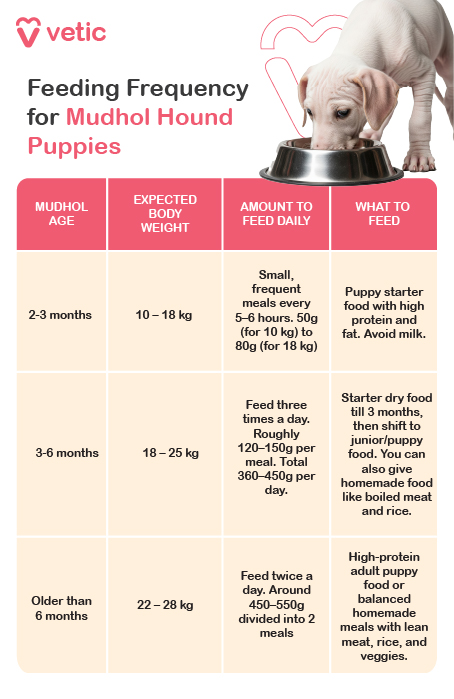
- 8 to 12 Weeks: 4 small meals a day. Their metabolism is fast and their stomachs are small.
- 12 to 24 Weeks: Transition to 3 meals a day as they grow and their digestive system matures.
- 6 Months and Up: Move to 2 meals a day. Stick to this even into adulthood to avoid overfeeding.
Keep meal times consistent and avoid exercise right before or after feeding, to lower the risk of bloating (gastric dilatation-volvulus), which some deep-chested dogs may be prone to.
Grooming Needs of Mudhol Hound Puppy
Mudhol Hounds are pretty low-maintenance in the grooming department, but that doesn’t mean you can skip it altogether. Their short, fine coat still needs routine care, especially since their skin can be sensitive.
Coat Care for Mudhol Hound Puppy
- Brushing: Brush once or twice a week using a soft-bristle brush or rubber grooming mitt. This helps remove loose hair and promotes circulation.
- Bathing: Once every 4–6 weeks or if they get particularly dirty. Use a mild puppy shampoo to avoid skin irritation.
- Ear Cleaning: Their ears are set high but still need attention. Clean gently once a week to prevent wax buildup and infections.
- Nail Trimming: Trim every 3–4 weeks. Long nails can affect their gait, especially since this is a running breed.
Dental Care for Mudhol Hound Puppy:
Start brushing their teeth early—2–3 times a week is ideal. Use a dog-safe toothbrush and toothpaste. This not only prevents dental disease but also gets them comfortable with routine oral care for life.
Mudhol Hound Puppy: Preventive Care That Keeps Up With Their Pace
Let’s Talk Preventive Care: What Does a Mudhol Hound Puppy Need to Stay Healthy?
Mudhol Hound puppies are athletic and resilient by nature, but like all young dogs, they require a structured preventive care plan to thrive. This includes timely vaccinations, parasite control, vet checkups, and healthy hygiene practices right from the start.
Here’s what their preventive care routine should cover:
- Vet Visits: Schedule a health check as soon as your puppy arrives home. Your vet will evaluate your pup’s condition, recommend a vaccination timeline, and discuss any breed-specific concerns.
- Dental Care: Start dental hygiene early. Brush your puppy’s teeth with a dog-safe toothbrush and toothpaste at least twice a week. Regular vet checks for oral health will help prevent tartar buildup and gum disease.
- Eye and Ear Care: While Mudhol Hounds typically have upright ears and healthy eyes, routine weekly cleaning can help prevent infections. Keep an eye out for unusual discharge, redness, or foul odour.
- Growth Monitoring: Because Mudhol Hounds are naturally lean, it can be difficult to judge their weight visually. Regular weight checks during vet visits will help ensure your puppy is growing at a healthy pace.
Vaccination Schedule for a Mudhol Hound Puppy
Vaccinations are essential to protect your puppy from contagious and often life-threatening diseases. A typical schedule in India may look like this:
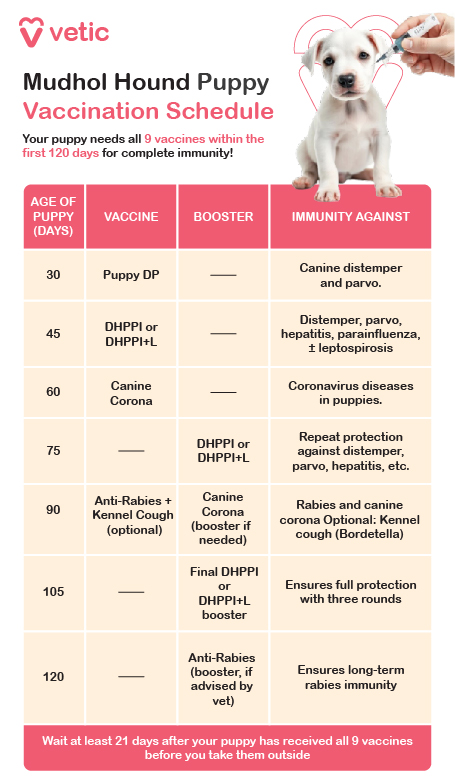
Some veterinarians may follow a two-shot DHPPiL protocol depending on the vaccine brand and your puppy’s health status. Always follow your vet’s specific advice.
Deworming of Mudhol Hound Puppy
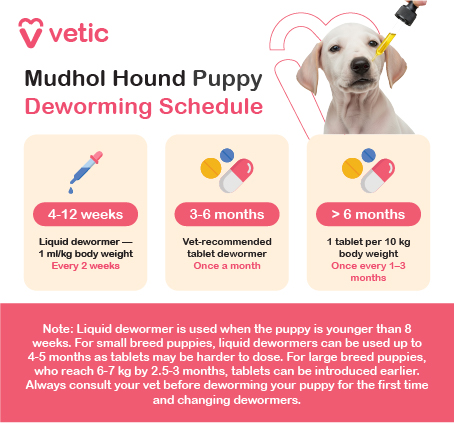
Mudhol Hound puppies should be dewormed every 2 weeks until 12 weeks of age, then monthly until 6 months, and every 3 months thereafter. Regular deworming protects against intestinal parasites and supports healthy growth and digestion.
The Importance of Socialization of Mudhol Puppies
Once your Mudhol Hound puppy is appropriately vaccinated, early socialization is strongly encouraged. Expose your puppy to new environments, people, and other dogs in a controlled and positive way. This helps prevent behavioural issues and contributes to a well-adjusted adult dog.
Mudhol Hound Puppy: Activities, Exercise, and Training Guide
Physical Activities: Smart Movement for a High-Energy Breed
Mudhol Hound puppies are athletic, alert, and naturally energetic—but they’re also still growing. The goal is to help them burn off energy in a safe, structured way that supports healthy development.
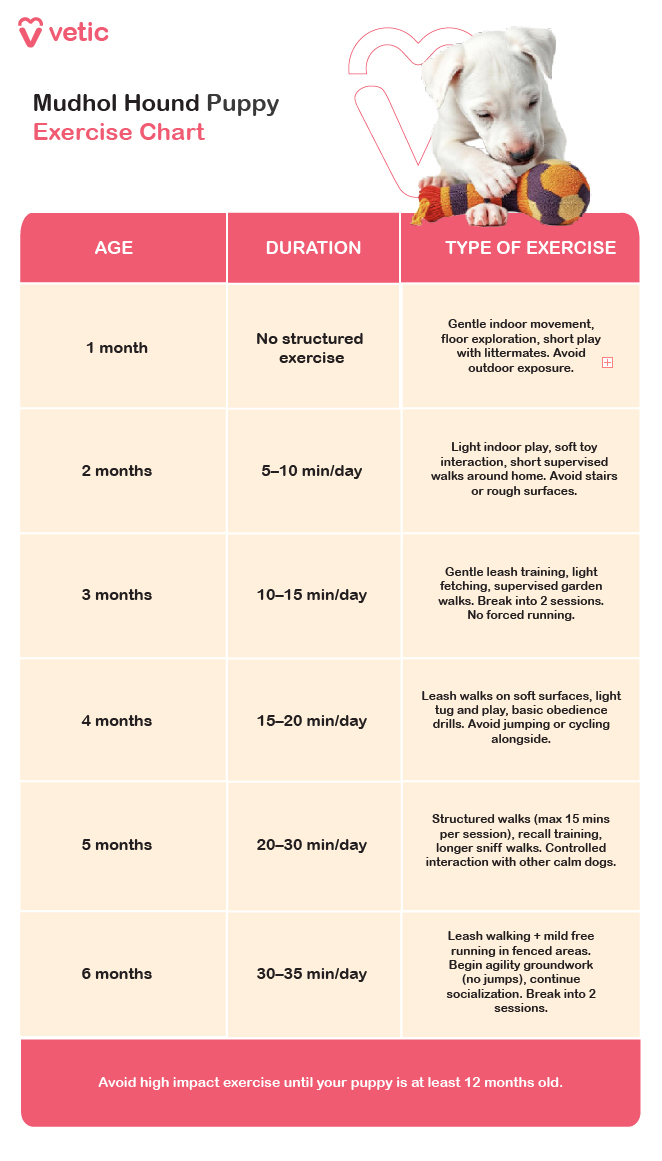
Play with Purpose: Short bursts of interactive play are perfect. Try tug toys, soft fetch, or chase games in a secure space. These pups thrive on movement, but sessions should be brief and spaced out through the day.
Walks with Caution: Begin with gentle 10–15 minute walks, 2–3 times a day. Mudhols are born sprinters, but long or intense walks should wait until their joints are more developed.
No Heavy Exercise Yet: Avoid activities like running beside a cycle or jumping exercises until your vet confirms it’s safe. Their slim, tall frames are still maturing and need joint protection.
Training: Start Young, Keep It Clear
Mudhol Hounds are intelligent and eager to please but can be independent. That means early, consistent training is essential—and repetition is your best friend.
House Training: Stick to a routine and reward outdoor potty breaks. Crate training helps with structure and makes learning easier.
Teach the Basics: Start with sit, stay, come, and leash walking. Keep sessions short and reward-based. Use calm, confident cues.
Early Socialisation: These sighthounds can be wary of strangers. Introduce them to different people, pets, sights, and sounds early to help build calm, balanced behaviour.
Mental Stimulation: Keep Their Brain Engaged
Mudhol Hound puppies are sharp observers. When not mentally challenged, they’ll find ways to entertain themselves (like digging or barking at everything that moves).
Try these brain-building activities:
- Puzzle feeders that make mealtime engaging
- Training games with scent work or object tracking
- Structured indoor obstacle paths using cushions, tunnels, or chairs
Behaviour Problems and Real-Life Fixes
Mudhol Hound puppies can show behavioural quirks if bored, under-exercised, or not guided early. Here’s what to watch for—and how to manage it.
Common Behaviour Challenges in Mudhol Hound Puppies:
Chewing: Teething happens. Offer textured chew toys and frozen washcloths to soothe their gums.
Chasing: As sighthounds, they love to chase moving objects. Redirect this with structured fetch or flirt pole games in a safe space.
Barking or Whining: They may bark at unfamiliar sights or sounds. Gentle desensitisation and distraction-based training work well.
Your Go-To Behaviour Training Strategies:
Redirection Works: If they’re chasing the cat or nipping your hands, calmly redirect to a toy or a sit command—and reward immediately.
Reward Good Behaviour: Whether it’s quiet time, walking calmly, or waiting before meals, reinforce it.
Consistency Above All: Keep commands, expectations, and schedules consistent across the household. It helps avoid confusion and builds trust.
Separation Sensitivity: Teach Independence Early
Though not usually clingy, Mudhol Hound puppies can still get anxious if left alone for too long without preparation.
Start by leaving them alone for a few minutes while you’re in another room. Gradually increase alone time, offering puzzle toys or comfort items to help them self-soothe.
With the right balance of structured activity, positive reinforcement, and mental challenges, your Mudhol Hound puppy will grow into a confident, calm, and well-mannered adult—true to the noble spirit of the breed.
Complete Care Guide for the Mudhol Hound Adolescent or Junior Pup
Mudhol Hound Adolescent: Comprehensive Nutrition & Grooming Guide
The adolescent stage (typically from 6 to 18 months) marks a period of rapid physical and behavioural development for the Mudhol Hound breed of dogs.
During this time, your young hound begins to show signs of their adult athletic build, stamina, and alert nature. Supporting this growth with proper nutrition and grooming is key to raising a strong, healthy, and well-adjusted adult.
Nutrition for Adolescent Mudhol Hounds
Mudhol Hounds have naturally lean frames and high energy levels. At this stage, they require a balanced diet that builds muscle, supports bone development, and fuels their active lifestyle—without leading to unnecessary weight gain.
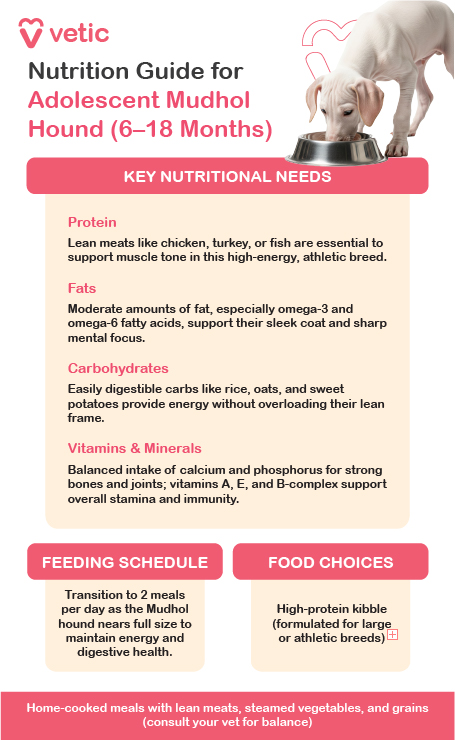
Nutritional Focus Areas
- High-Quality Protein: Include easily digestible animal proteins such as chicken, fish, or lamb to support muscle and tissue development.
- Healthy Fats: Omega-3 and omega-6 fatty acids promote healthy skin and help maintain the natural sheen of their short, fine coat.
- Complex Carbohydrates: Incorporate brown rice, barley, or sweet potatoes for steady energy release.
- Essential Vitamins & Minerals: Calcium and phosphorus are vital for skeletal growth, while antioxidants (like vitamins A, E, and C) help boost immunity and support cellular repair.
Feeding Options
- Commercial Dog Food: Choose a large-breed puppy or junior formula suited for high-energy breeds. Brands like Farmina N&D, Arden Grange, and Royal Canin offer suitable options.
- Home-Cooked Meals: If feeding home-prepared food, ensure a mix of lean meat, vegetables like carrots and spinach, and whole grains. Always consult your vet for appropriate supplementation.
- Wet Food & Toppers: These may be offered occasionally to enhance flavour and hydration but should not replace balanced meals.
Feeding Frequency and Timing
- 6 to 12 Months: Offer 2–3 meals per day depending on the pup’s activity level and weight.
- 12 to 18 Months: Transition to 2 meals a day, aligning with your Mudhol’s adult routine.
Stick to a fixed feeding schedule and use portion control to prevent overfeeding. Avoid meals right before or after vigorous exercise.
Grooming Needs of a Mudhol Hound Adolescent
Mudhol Hounds have short, tight coats and relatively low grooming demands. However, maintaining a basic grooming routine during adolescence ensures good hygiene and helps detect any early skin or coat issues.
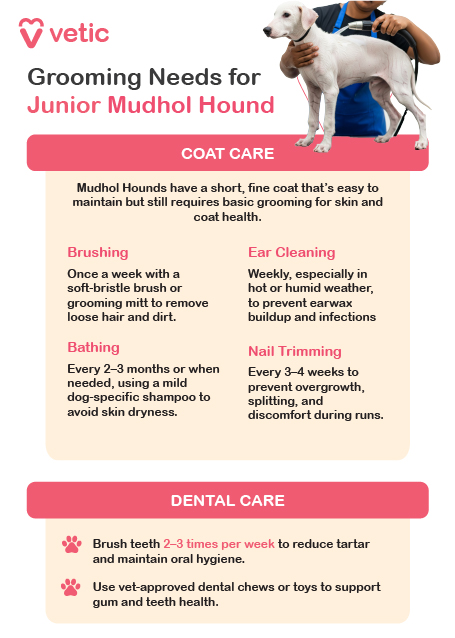
Coat Care
- Brushing: A soft-bristle or rubber grooming brush used once or twice a week is enough to remove loose hair and stimulate skin oils.
- Bathing: Bathe once every 2–3 months or as needed using a mild, dog-specific shampoo. Overbathing can dry out their skin.
Ear Cleaning
Check and clean the ears weekly. Although their ears are not fully floppy, moisture or dirt can still lead to infections if not monitored.
Nail Trimming
Trim nails every 3–4 weeks. If you can hear their nails clicking on hard surfaces, it’s time for a trim. Regular trimming helps prevent joint stress and foot splay.
Dental Care for Mudhol Hound Juniors
Begin building a regular dental hygiene routine in adolescence.
- Brush the teeth 2–3 times a week using dog-safe toothpaste.
- Offer dental chews or safe chew toys to help manage plaque and encourage healthy gums.
Mudhol Hound Adolescent: Complete Vaccination, Deworming & Healthcare
As your Mudhol Hound enters adolescence (typically between 6 and 18 months), their body and behaviour continue to mature. This stage is crucial for building long-term health, and proper preventive care plays a major role in supporting their growth, agility, and overall wellbeing.
Preventive Care and Vaccination Schedule
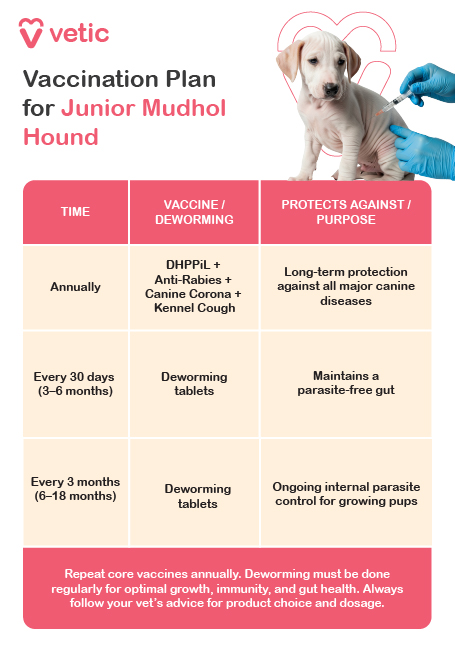
Vaccinations for Mudhol Hound Junior
By this age, most Mudhol Hound puppies would have completed their core vaccination schedule. However, booster doses are important to ensure lasting protection.
- 12 Months: Administer booster shots for core vaccines (9-in-1 vaccine, rabies) as advised by your veterinarian.
- Optional Vaccines: Depending on your region and your dog’s exposure risk, your vet might recommend additional vaccines such as Bordetella (kennel cough), or Canine Influenza.
Parasite Prevention: Consistency Is Key
Mudhol Hounds have short coats but active outdoor routines, making them vulnerable to parasites.
- Flea and Tick Control: Use monthly preventives year-round, especially if your dog walks in grassy or wooded areas.
- Heartworm Protection: Continue monthly heartworm prevention. Mosquito exposure in many parts of India makes this essential.
Regular Veterinary Visits
Schedule a check-up every 6 months to track your Mudhol Hound’s development. These visits allow your vet to assess musculoskeletal health, dental hygiene, and detect early signs of illness or dietary imbalances. If you notice any sudden changes in your dog’s activity, appetite, or behaviour, don’t wait. Consult your vet.
Health Risks and What to Watch Out For
The Mudhol Hound is generally a hardy breed, but adolescence can bring some specific health concerns you should monitor closely.
Common Health Concerns in Mudhol Adolescents
- Orthopaedic Strain: Rapid growth may place pressure on developing joints. Monitor for signs like limping, stiffness, or hesitation during activity.
- Underweight Risk: Due to their naturally lean build, Mudhol adolescents may appear thin. Ensure they’re eating well and not showing signs of malnutrition or low energy.
- Digestive Upsets: Sudden changes in food, scavenging, or treats outside their diet can lead to gastrointestinal distress.
- External Injuries: Their speed and curiosity can lead to minor injuries, especially around sharp objects or uneven ground.
Signs That Indicate Health Issues in Mudhol Hounds
- Lameness or reluctance to walk or run
- Digestive issues like vomiting or diarrhoea
- Excessive scratching or hair loss
- Change in appetite or weight
- Sudden behavioural changes or anxiety
With the right preventive care, regular vet checks, and a watchful eye, your adolescent Mudhol Hound can transition smoothly into a fit, alert, and well-balanced adult.
Mudhol Hound Junior: Training and Behaviour
Adolescence in Mudhol Hounds (around 6 to 18 months) brings out their signature speed, independence, and alertness. But it also introduces challenges like testing limits and occasional stubbornness.
With consistent training, regular exercise, and mental stimulation, your junior Mudhol Hound can grow into a well-mannered and focused adult.
Activities, Exercise, and Training for Mudhol Juniors
Physical Activities for Mudhol Hound Juniors
Mudhol Hounds are built for speed and endurance. They need structured outlets to channel their energy productively.
- Daily Walks and Runs: Two sessions of 30–45 minutes of brisk walking or trotting daily help maintain physical health and reduce restlessness.
- Off-Leash Play (in Safe Areas): These sighthounds enjoy free running—but only in enclosed or secure spaces, as they tend to chase moving objects.
- Scent Walks: Letting them sniff and explore during walks is mentally enriching and calms their active mind.
Training: Clarity, Consistency, and Calmness
Mudhol Hounds are intelligent but can be independent. Training should focus on building trust and using clear, consistent cues.
- Recall and Leash Skills: Early and ongoing recall training is essential, especially for off-leash time. Leash manners are also a must at this stage.
- Basic to Advanced Obedience: Continue reinforcing commands like “stay,” “leave it,” and “come.” Add distractions gradually to improve their focus.
- Impulse Control: Practice “wait” before meals or “stay” before heading out for walks to improve self-regulation.
Mental Stimulation: Keep Their Mind Active
Though more physically driven, Mudhol Hounds benefit from activities that challenge their brain.
- Rotate toys, introduce simple puzzle feeders, and hide treats around the house for a sniff-and-seek game.
- Teach new commands or basic agility cues to build engagement and discipline.
Behaviour Problems and Solutions
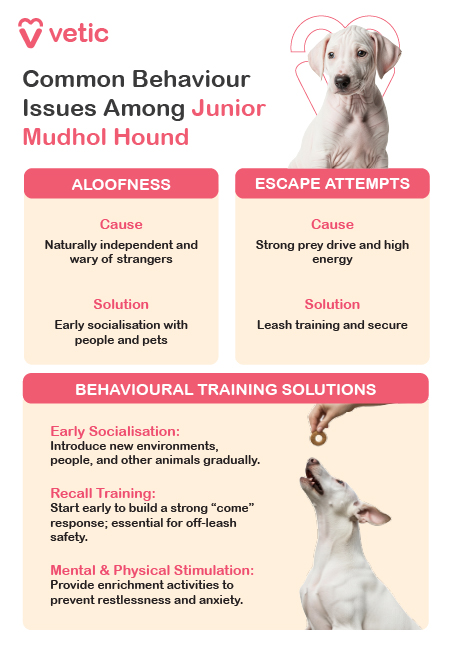
Common Behaviour Issues of Mudhol Juniors
- Excessive Pulling: Their high prey drive can lead to strong pulling on walks. Use front-clip harnesses and reinforce calm walking.
- Restlessness or Pacing: Without adequate exercise, Mudhol adolescents may show restlessness indoors. Prioritise daily activity
- Chasing Small Animals: It’s in their instincts. Train with positive reinforcement to redirect attention when needed.
Training Strategies That Work for Mudhol Adolescents
- Positive Reinforcement: Mudhol Hounds respond well to calm praise, treats, and structured reward systems. Avoid harsh correction—it can create distrust.
- Consistency: Use the same commands, tones, and rules to prevent confusion and build habits.
- Redirection: If they show unwanted behaviour like barking at movement outside or chewing, redirect them calmly toward a toy or command.
Separation Anxiety: Not Always, But Still Possible
Mudhol Hounds are generally more independent, but some may develop mild separation stress if left for long hours without activity. To ease this:
- Provide chew toys or long-lasting treats before leaving
- Keep departures low-key and return routines calm
- Build up alone-time gradually if needed
Complete Care Guide for the Mudhol Hound Adult Dog
Mudhol Hound Adult: Comprehensive Nutrition Guide
Mudhol Hounds are agile, alert, and naturally lean. As they transition into adulthood (approximately 18 months to 7 years), their nutritional needs shift from growth to maintenance. The focus now is on fuelling stamina, supporting joint and muscle health, and keeping their slim frame in optimal condition.
Nutritional Needs for Adult Mudhol Hounds
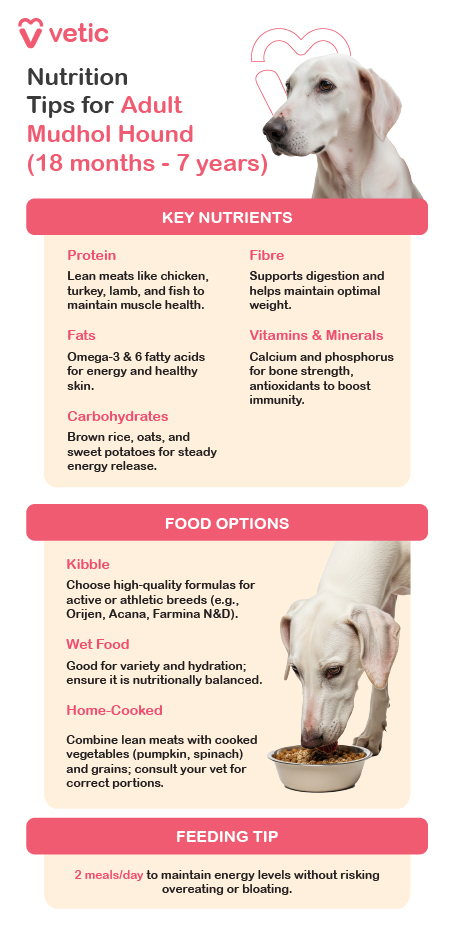
Mudhols are athletic but sensitive dogs. Their diet should support endurance, prevent digestive upset, and maintain joint flexibility.
- Protein: Opt for lean, high-quality sources like chicken, turkey, or fish to maintain muscle mass without unnecessary fat.
- Healthy Fats: Moderate levels of omega-3 and omega-6 fatty acids (from fish oil or flaxseed) help support their coat, skin, and brain health.
- Complex Carbs: Choose gentle, digestible carbs such as brown rice, oats, or sweet potatoes to sustain energy without weighing them down.
- Fibre: A small amount of fibre aids digestion—especially important since some Mudhols may have sensitive stomachs.
- Vitamins & Minerals: Include antioxidants like vitamin E and C for immune support, along with glucosamine and chondroitin to protect their long legs and joints during high-speed activities.
Food Options for Mudhol Hound Adults
Choose a diet that suits your Mudhol’s individual preferences while meeting their nutritional needs.
- Commercial Kibble: Select premium adult formulas for medium to large active breeds from trusted brands like Farmina, Arden Grange, or Royal Canin. Ensure it’s formulated for active dogs with joint support.
- Wet Food: Offers hydration and variety but should be complete and balanced if fed exclusively.
- Home-Cooked Meals: A mix of lean meats, vegetables, and grains can work well—but always consult your vet or a canine nutritionist for proper proportions.
Feeding Frequency and Routine for Adult Mudhol Hound
18 Months and Up: Feed twice a day to support stable energy release and reduce the risk of digestive issues.
- Stick to a regular meal schedule. Predictability helps digestion and behaviour.
- Avoid feeding right before or after exercise to reduce the risk of bloat, which can be a concern for deep-chested breeds like the Mudhol Hound.
A well-nourished Mudhol Hound is not just graceful in movement but healthy and resilient.
Mudhol Hound Breed Adult: Preventive Heathcare Guide
Vaccination and Deworming Schedule for Mudhol Hound Adults
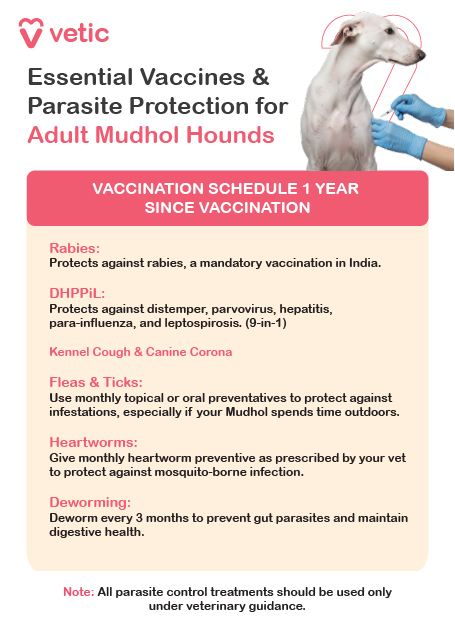
Vaccination Schedule for Adult Mudhol Hounds:
By adulthood, your Mudhol Hound should have completed its core puppy vaccinations. However, adult dogs still require timely boosters and optional vaccines based on individual risk.
- Annual Boosters: Your vet may recommend annual or tri-annual boosters for core vaccines like Rabies, and 9-in-1.
- Optional Vaccines: Depending on your region and your dog’s lifestyle, your vet may advise vaccines for Kennel Cough (KC), and Canine Coronavirus (CC).
Tick, Flea and Worm Control for Mudhol Hound Adults:
- Flea and Tick Prevention: Due to their outdoor activity and short coat, Mudhol Hounds are at risk of external parasites. Apply monthly preventives—either spot-on treatments or oral tablets.
- Heartworm Prevention: Continue monthly heartworm prevention as per your vet’s guidance, especially in endemic areas.
Regular Vet Check-ups:
Schedule an annual health check to assess your Mudhol Hound’s heart, joints, dental health, weight, and internal health. Bloodwork or urine tests may be recommended to catch early signs of illness, especially in active or working dogs.
Grooming Necessities and Frequency for Adult Mudhol Hounds
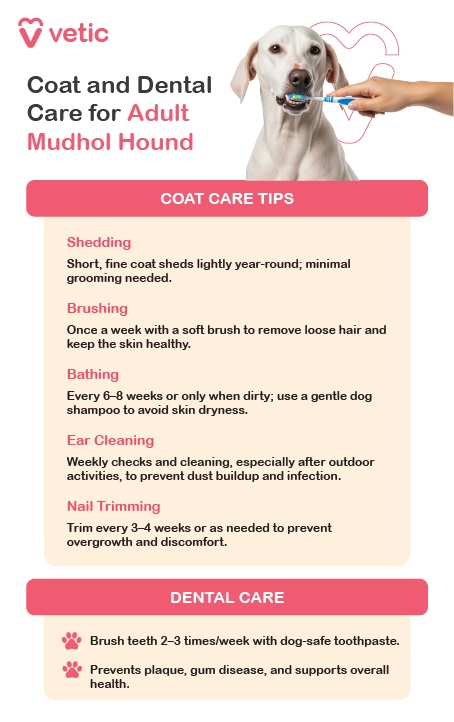
Coat Care:
Mudhol Hounds have a short, close-lying coat that is easy to maintain but still requires routine care.
- Brushing: Brush once a week using a soft bristle or rubber grooming mitt to remove dead hair and stimulate skin health.
- Bathing: Bathe your Mudhol only when necessary—typically every 2-3 months. Use a gentle, hypoallergenic dog shampoo to avoid skin dryness.
Ear Cleaning:
Although less prone to infections than floppy-eared breeds, regular ear checks and cleaning once every two weeks help prevent wax buildup and irritation, especially after outdoor runs.
Nail Trimming:
Trim the nails every 3-4 weeks or as soon as you hear them clicking on hard floors. Overgrown nails can affect gait and lead to injury.
Dental Care for Mudhol Adult:
Brush your Mudhol Hound’s teeth 2-3 times a week using a soft dog toothbrush and dog-safe toothpaste. This helps prevent tartar buildup and maintains oral hygiene.
Health Risks and What to Watch Out For in Mudhol Hounds
Common Health Risks of Mudhol Hound Adults:
- Hip and Hock Weakness: Watch for limping, wobbliness, or reluctance to run or climb.
- Progressive Retinal Atrophy (PRA): Early signs include night blindness or bumping into objects.
- Gastrointestinal Sensitivity: Be cautious of changes in diet. Symptoms like loose stools, bloating, or vomiting should be addressed promptly.
- Muscle Loss or Poor Weight Maintenance: Even with a healthy appetite, Mudhols may show visible ribs or reduced stamina if undernourished or overexercised.
- Soft Tissue Injuries: Their athletic build makes them prone to sprains or strains. Limping or sudden reluctance to move are red flags.
- Temperature Sensitivity: Keep an eye on them during extreme weather. Heavy panting, shivering, or lethargy may indicate thermal stress.
Signs to Watch For:
- Changes in gait, limping, or decreased running enthusiasm
- Sudden weight loss despite regular feeding
- Night vision difficulties or disorientation in low light
- Diarrhoea, vomiting, or visible bloating after meals
- Fatigue, withdrawal, or reluctance to engage in physical activity
If any of these signs are observed, consult your veterinarian for timely diagnosis and treatment. Early care can make a significant difference in your Mudhol Hound’s long-term health.
Mudhol Hound Adult: Activities and Behavioural Training
Mudhol Hounds are intelligent, alert, and built for speed. As adults, they require a well-balanced mix of physical exercise and mental stimulation to remain fit, focused, and well-behaved. Due to their independent nature, training should be consistent but respectful of their temperament.
Activities, Exercise, and Training for Mudhol Hound Breed Adults

Physical Activities for Mudhol Adult:
Mudhol Hounds are natural athletes with high stamina. Regular exercise is essential not only for their health but also to prevent restlessness or destructive behaviour.
- Daily Walks: Provide at least 60 minutes of brisk walking or running daily, ideally split into two sessions. They benefit from open space where they can safely sprint.
- Free Running: If you have access to a secure and open area, allow short off-leash sprints to satisfy their instinct to run.
- Chase and Lure Play: Use flirt poles or lure courses to engage their prey drive and offer structured, fun movement.
Training and Commands for Mudhol Hound Adults:
Though intelligent, Mudhol Hounds can be independent and sometimes aloof. Early socialisation and gentle, consistent training methods work best.
- Reinforce Basic Commands: Regularly practise “sit,” “stay,” and “come” in low-distraction environments.
- Recall Training: Prioritise off-leash recall as Mudhols have a strong chase instinct and may bolt if untrained.
- Leash Manners: Begin loose-leash walking early and practise regularly—this breed is fast and may pull if not trained properly.
- Controlled Socialisation: Gradually expose them to new people, sounds, and settings to reduce sensitivity and build confidence.
Mental Stimulation Needs for Mudhol Hound Breed Adult:
Being sighthounds, Mudhols thrive with activities that engage their natural instincts.
- Use puzzle toys, scent games, and interactive feeders.
- Teach short bursts of new commands or tricks—they prefer focused sessions over long ones.
- Allow supervised outdoor observation from a secure yard—they enjoy quietly surveying their surroundings.
Behaviour Problems and Solutions for Mudhol Breed Adult
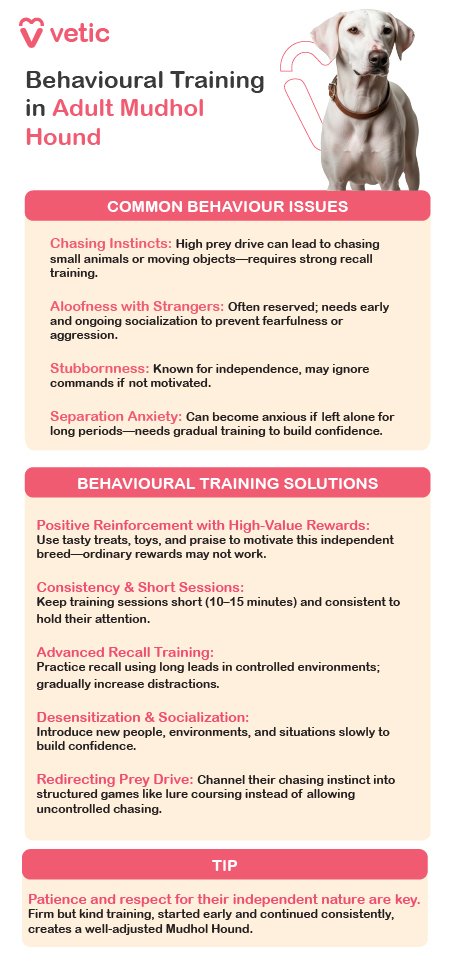
Common Behaviour Issues in Mudhol Hound Adult:
- Chasing Small Animals: Their strong prey drive may lead to chasing. Always supervise off-leash time unless in a secure area.
- Timidness or Aloofness: If undersocialised, some Mudhols may become wary of strangers or new experiences.
- Destructive Behaviour: Without enough physical or mental activity, they may chew or dig.
Behavioural Training Solutions for Mudhol Hound:
- Positive Reinforcement: Use praise, treats, and calm repetition to encourage good behaviour. Avoid harsh corrections—they may become unresponsive or withdrawn.
- Routine: Stick to consistent walk, feeding, and rest times. Mudhols do best when they know what to expect.
- Redirection: If unwanted behaviour arises, offer a toy, command, or a calming activity to shift their focus.
Managing Separation Anxiety in Mudhol Hounds:
Though generally independent, Mudhols form close bonds with their families. If left alone too long, they may develop anxiety or restlessness. Provide mental enrichment before leaving, and ease them into longer periods of alone time gradually.
Complete Care Guide for Your Mudhol Hound Senior
Mudhol Hound Senior: Comprehensive Nutrition Guide
From about 7 years onwards, Mudhol Hounds enter their senior phase. Their metabolism slows, joints may stiffen, and overall energy needs decrease.
With thoughtful nutrition, you can help your Mudhol companion stay lean, agile, and healthy well into its golden years.
Nutritional Needs for Senior Mudhol Hounds
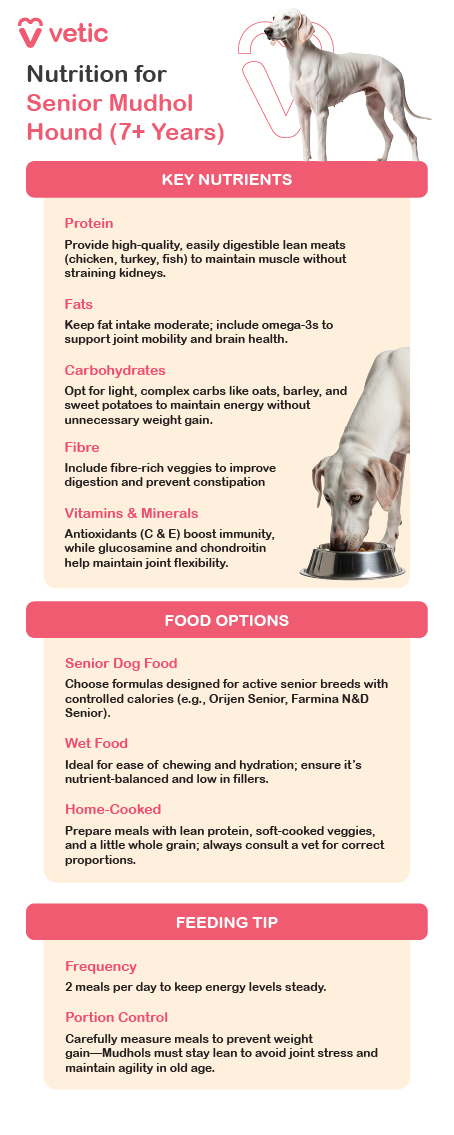
Senior Mudhol Hounds benefit from diets formulated to counter common age-related changes:
- Protein: Maintain high‑quality, easily digestible sources like chicken, fish, or turkey. As dogs age, their ability to build protein declines, so protein levels should remain adequate for muscle maintenance.
- Healthy Fats: Include omega‑3 fatty acids (EPA/DHA) from fish oil to support joint comfort and cognitive health while moderating total fat content to prevent unwanted weight gain.
- Complex Carbohydrates & Fibre: Gentle carbs like sweet potato, brown rice, and barley provide steady energy. Fibre such as beet pulp or flaxseed supports digestion and gut health, which senior dogs often struggle with.
- Vitamins & Minerals: Antioxidants (vitamins C and E) help shield aging cells. Joint-support nutrients like chondroitin and glucosamine support mobility. A concern even though Mudhol hounds are generally athletic.
- Minerals for Bone & Skin: Adequate calcium, phosphorus and trace elements like zinc and copper support skeletal integrity and healthy skin as collagen production declines with age.
Food Options for Mudhol Senior Hounds
Choose diet options that support their lean physique and gentler digestion:
- Senior Medium-Breed Kibble: Opt for utter low-fat, senior-specific formulations from premium brands designed for active or working breeds. Look for added joint and antioxidant support.
- Wet Food: Suitable for dogs with reduced appetite or dental issues. Must be a complete senior formula.
- Home-Cooked Meals: If preparing meals at home, include lean meats, soft- cooked veggies (like squash or carrot), and easy-to-digest whole grains. Consult your vet to avoid nutrient gaps.
- Supplement Consideration: Products with probiotics or prebiotics can help digestive health; fish oil or joint supplements can aid mobility.
Feeding Frequency and Timing
- 7 Years and Up: Stick to two meals per day to support stable digestion and metabolic balance.
- Portion Control: Seniors need 20–25% fewer calories due to reduced activity; adjust portions based on weight and condition.
- Meal Timing: Avoid feeding immediately before or after walks to reduce risk of bloat, even though Mudhols are less bloat-prone than some deep-chested breeds, caution is still advisable.
Mudhol Hound Senior: Complete Healthcare Guide
As Mudhol Hounds enter their senior years, they require more attentive care to remain healthy and comfortable. With a proactive approach to preventive care and regular monitoring, your graceful sighthound can continue to enjoy an active and dignified life.
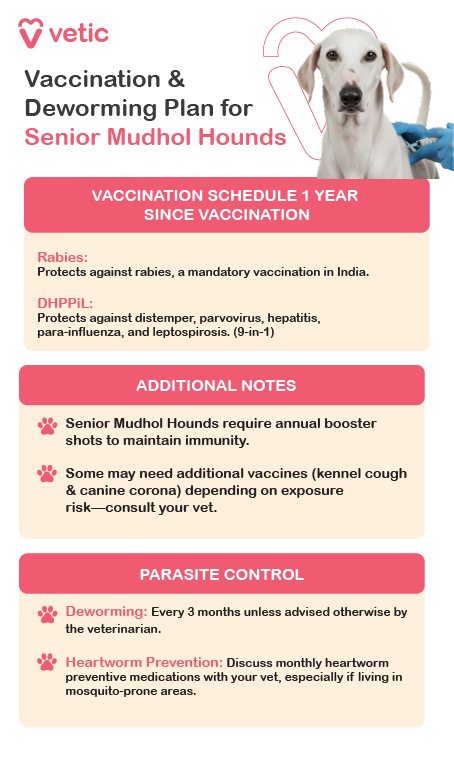
Vaccination and Deworming Schedule for Older Mudhol Hounds
Vaccination Schedule for Mudhol Seniors:
Senior Mudhol Hounds should continue receiving core vaccinations as advised by your veterinarian. Their vaccination needs may be adjusted based on their age, activity level, and medical history.
- Annual Boosters: Core vaccines such as Rabies, Distemper, and Parvovirus may still be required annually or once every three years. Your vet will determine the best schedule for your dog’s health.
- Optional Vaccines: If your Mudhol still travels, boards, or interacts with other dogs, vaccines for Bordetella and Lyme disease may be considered.
Deworming for Mudhol Hound Seniors:
Even in old age, your Mudhol needs consistent protection from parasites.
- Flea & Tick Prevention: Continue using appropriate flea and tick preventatives year-round. Choose gentle, vet-approved options, especially if your dog has developed sensitive skin.
- Heartworm Prevention: Monthly heartworm protection remains essential unless advised otherwise by your veterinarian.
Grooming Necessities and Frequency for Senior Mudhol Hounds:
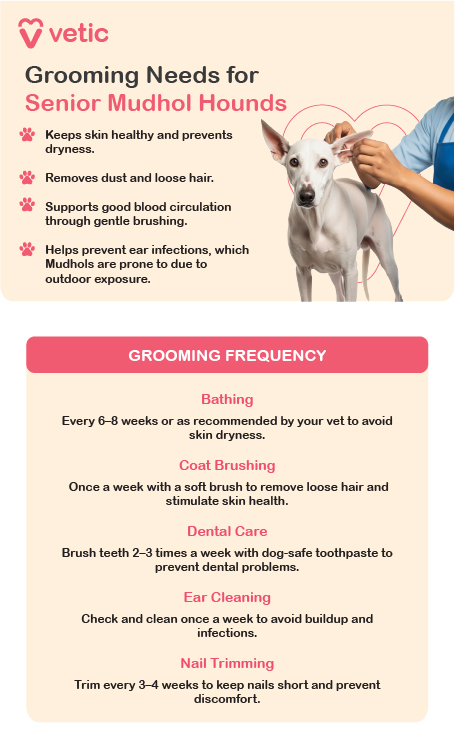
Coat Care:
Mudhol Hounds have a short coat that offers little protection, and seniors are more vulnerable to bruising and skin tears.
Brushing:
Use an ultra-soft bristle brush or a microfiber grooming mitt once a week to remove loose hair without damaging the skin. Avoid vigorous brushing.
Bathing:
Bathe only when necessary—around every 3-4 months—to prevent drying out their fragile skin. Always use a mild, moisturizing dog shampoo formulated for sensitive skin.
Ear Cleaning:
Continue ear checks once every two weeks, but use extra care to avoid scratching the delicate ear skin. Gentle, vet-approved ear cleaners are recommended.
Nail Trimming:
Trim nails every 3-4 weeks to maintain proper gait. Use a nail grinder instead of clippers if your senior’s nails are brittle, to avoid splitting or injury.
Dental Care for Mudhol Hound Seniors:
Brush teeth 2-3 times a week using a soft toothbrush and dog-safe toothpaste. If arthritis makes home brushing difficult, ask your vet about professional cleanings under safe anesthesia protocols for seniors.
Regular Vet Check-ups:
Older Mudhol Hounds benefit greatly from bi-annual veterinary check-ups to detect early signs of age-related conditions.
Your vet may suggest the following screenings:
- Complete blood panel (CBC)
- Biochemistry tests
- Urinalysis
- Thyroid function tests
- Imaging (X-rays) to assess joints or internal organs, if necessary
Health Risks and What to Watch Out For
Though generally hardy, senior Mudhol Hounds are still vulnerable to several age-associated health conditions. Recognising symptoms early can lead to more effective management.
Common Health Concerns:
- Arthritis and Joint Pain: Age-related wear and tear can affect mobility. Watch for limping, stiffness after resting, or reluctance to walk or run.
- Muscle Wasting: Mudhols are naturally lean. Sudden loss of muscle tone, especially in the hindquarters, could indicate age-related muscle degeneration or a neurological issue.
- Obesity or Weight Loss: A slowed metabolism can lead to unexpected weight gain or loss. Monitor weight regularly and adjust diet accordingly.
- Hypothyroidism: Though not very common in Mudhols, this condition may still occur. Signs include lethargy, weight gain, or skin infections.
- Canine Cognitive Dysfunction: Disorientation, pacing at night, or confusion indoors may suggest age-related cognitive decline.
- Heart Conditions: Although rare in the breed, older dogs should still be monitored for coughing, fatigue, or breathing difficulty.
Signs That Need Vet Attention
- Difficulty rising or moving after rest
- Noticeable changes in weight or muscle mass
- Slower walking, limping, or reluctance to climb stairs
- Persistent cough, wheezing, or shortness of breath
- Changes in appetite, water intake, or toilet habits
- Signs of confusion, restlessness at night, or increased anxiety
If you observe any of these signs, schedule a checkup. Early intervention can significantly improve your Mudhol Hound’s comfort and quality of life in their later years.
Mudhol Hound Senior: Activity, Exercise & Behaviour Training
As your Mudhol Hound reaches senior status, their stamina may be reduced, but gentle, consistent activity remains vital.
Physical exercise supports mobility and mental well-being, while thoughtful training and enrichment help preserve their intellect and emotional health.
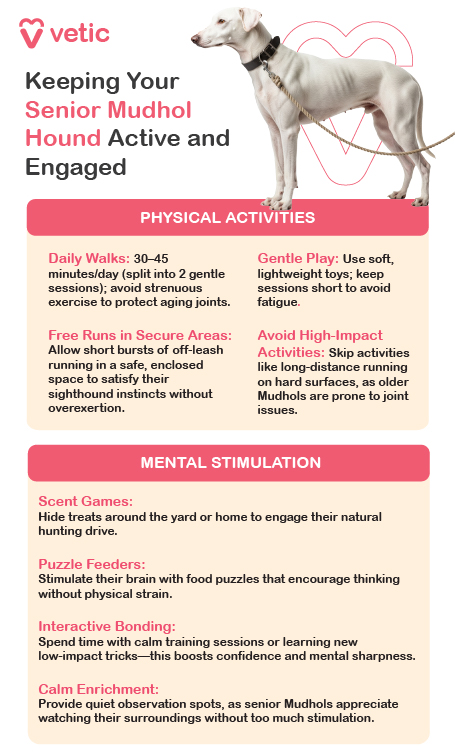
Physical Activities Suitable for Senior Mudhol Hounds
Even senior Mudhol Hounds benefit from daily low-impact movement to maintain strength and flexibility.
- Gentle Walks: Aim for 20–30 minutes of walking twice a day. Keep the pace moderate and avoid uneven ground—especially if arthritis has begun.
- Limited Free Runs: If available, allow short off-leash bursts in a fenced or secure area to satisfy their instinctual drive—just monitor closely and avoid long or strenuous runs.
- Swimming (if possible): Water-based movement is ideal for aging joints, only in safe, easy-access pools or calm water with supervision.
- Strength and Flexibility Moves: Home-based exercises like slow sit-to-stand repetitions or gentle walking on different surfaces can support joint health and balance.
Training and Mental Engagement Necessary for Senior Mudhol Hounds
Continued training and cognitive stimulation help keep your senior Mudhol alert, confident, and behaviourally stable.
- Refresher Commands: Reinforce easy commands like “sit,” “come,” and “wait” using low-distraction sessions and gentle praise. Even basic training keeps their mind active.
- Adapt to Sensory Changes: If hearing or vision declines, shift to hand signals or gentle touch cues. Stay calm and clear to reduce confusion.
- Obstacle Games for Seniors: Encourage engagement with simple scent games or low hurdles (modified agility) to support both physical and mental health.
Behavior Issues & Solutions for Mudhol Breed Seniors
Older Mudhol Hounds may face specific behavioural challenges tied to age or cognitive change but gentle management works well.
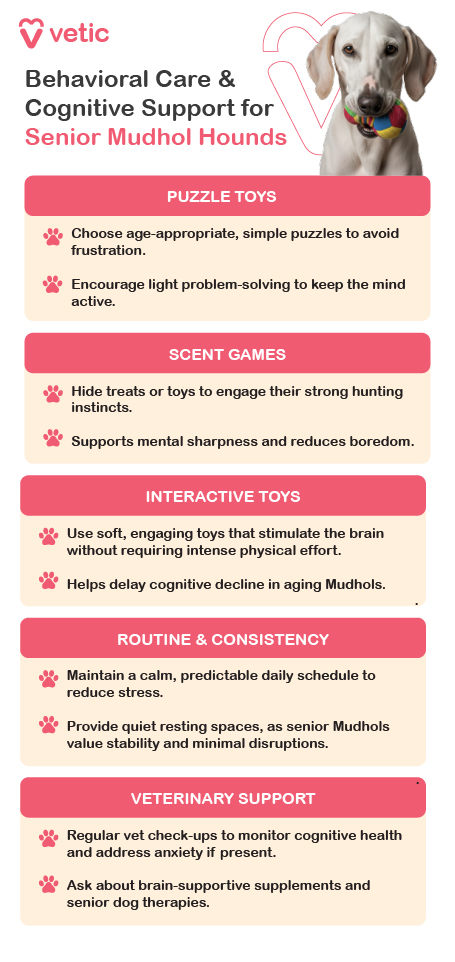
Common Issues:
- Restlessness or pacing: May stem from discomfort or cognitive shift.
- House Soiling: Even healthy Mudhols may have more frequent accidents due to bladder changes.
- Increased Vocalisation or Wandering: Early signs of cognitive decline or stress in unfamiliar routines.
Effective Strategies:
- Gentle Routines: Maintain a consistent daily routine, structured meal times, walks, and rest periods provide stability.
- Positive Reinforcement: Use calm praise, soft treats, and short interaction to reinforce desired behaviours. Avoid correction or loud tones. They can cause anxiety.
- Redirection: If restlessness or barking occurs, redirect them to a chew toy or calm scent puzzle.
Supporting Cognitive Health of Mudhol Seniors
Mental stimulation and sensory engagement can slow cognitive decline and support brain function, even in senior dogs.
- Puzzles and Treat Games: Snuffle mats, scent hidden treats, or activity boards help keep the mind sharp.
- Short Training Sessions: Engage your Mudhol in simple commands or tricks based on their ability—this reinforces memory and attention.
- Sensory Walks: Slow-motion walks that focus on sniffing new scents can be calming and enriching.
Your veterinarian may recommend supplements (like antioxidants or omega‑3s) or prescription diets to assist cognitive function as needed. Combining mental engagement with nutrition seems to yield the best results.
Should You Adopt a Mudhol Hound?
The Mudhol Hound is a magnificent Indian breed that thrives with experienced pet parents who understand its unique temperament and exercise needs. While not particularly expensive to maintain in terms of food or grooming, this breed does require a dedicated lifestyle – one that includes ample space to run, consistent training, and regular health monitoring. Mudhols or Caravan Hound are best suited to active households, rural or semi-urban settings, and people who appreciate an independent yet loyal companion. Due to their high energy, prey drive, and strong-willed nature, they may not be ideal for first-time dog owners. But for the right family, they offer unmatched elegance, devotion, and pride in preserving a piece of India’s living heritage.
